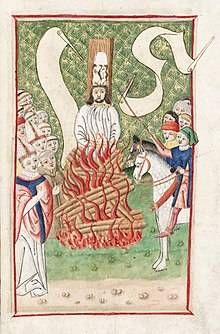Death and culture
In most cultures, after the last offices have been performed and before the onset of significant decay, relations or friends arrange for ritual disposition of the body, either by destruction, or by preservation, or in a secondary use.
Another method is sky burial, which involves placing the body of the deceased on high ground (a mountain) and leaving it for birds of prey to dispose of, as in Tibet.
Such practice may also have originated from pragmatic environmental issues, such as conditions in which the terrain (as in Tibet) is too stony or hard to dig, or in which there are few trees around to burn.
Since ancient times, in some cultures efforts have been made to slow, or largely stop the body's decay processes before burial, as in mummification or embalming.
Alternatively, a green burial is not a new process, but a very old one involving burying the unpreserved remains in a wood coffin or casket, which will naturally decompose, and thus not permanently take up land.
[8] Those practicing cryonics hope that future technology will allow the legally dead person to be restored to life when and if science is able to cure all disease, rejuvenate people to a youthful condition and repair damage from the cryopreservation process itself.
It's a courtesy, that when a person passes away; all those friends and relatives "who loved him" must definitely make it to his funeral and stand by the grieved family at such a critical phase of bereavement.
Iran accounts for two-thirds of the global total of such executions, and currently has roughly 120 people on death row for crimes committed as juveniles (up from 71 in 2007).
Opponents of capital punishment argue that it does not deter criminals more than life imprisonment, violates human rights, leads to executions of some who are wrongfully convicted, and discriminates against minorities and the poor.
Individual actions of war within a specific campaign are traditionally called battles, although this terminology is not always applied to contentions in modernity involving aircraft, missiles or bombs alone in the absence of ground troops or naval forces.
Where disputes arise over issues such as sovereignty, territory, resources, ideology and a peaceable resolution is not sought, fails, or is thwarted, war often results.
In the desperate final days of World War II, many Japanese pilots volunteered for kamikaze missions in an attempt to forestall defeat for the Empire.
In Nazi Germany, Luftwaffe squadrons were formed to smash into American B-17s during daylight bombing missions, in order to delay the highly-probable Allied victory, although in this case, inspiration was primarily the Soviet and Polish taran ramming attacks, and death of the pilot was not a desired outcome.
Most Western and Asian religions—the Abrahamic religions, Buddhism, Hinduism—consider suicide a dishonorable act; in the West it was regarded as a serious crime and offense against God due to religious belief in the sanctity of life.
Japanese views on honor and religion led to seppuku being respected as a means to atone for mistakes or failure during the samurai era.
Suicide attempts can be many times interpreted as a "cry for help" and attention, or to express despair and the wish to escape, rather than a genuine intent to die.
Laws around the world vary greatly with regard to euthanasia and are subject to change as people's values shift and better palliative care or treatments become available.
From an anthropological standpoint, this perspective emerges from a historical narrative that elevates human rationality as a guide for ethical decision making.
The endorsement of individualism and human reason during the Enlightenment era left a profound impact on Western culture with its advocation of these values, influencing how personal agency is perceived in matters of life and death (Zafirovski, 2011).
Advocates of euthanasia emphasize an individual’s ability to exert control over the timing and circumstances of their passing, aligning with the concept of a dignified death.
However, a deeper analysis reveals that this Western cultural perspective may not fully encompass the intricate interplay of family dynamics, social pressures, and communal values that influence an individual’s end of life decision making (Mwaria, 1997).
Family relationships, deeply ingrained in cultural norms of care and support, can introduce complexities into the decision-making process surrounding euthanasia.
Additionally, the influence of cultural expectations and societal norms can create tensions between the pursuit of personal autonomy and the recognition of broader social responsibilities.
India allows for patients to choose passive euthanasia should they wish to, having the right to “request that the treatment be stopped or withdrawn once it has started” (Kumar, 2023).
Although not necessarily representative of the population’s individual opinions, these values have influenced the greater morals and laws of the West and are still prominent to this day.
Eternal return is a non-religious concept proposing an infinitely recurring cyclic universe, which relates to the subject of the afterlife and the nature of consciousness and time.
Some terminally ill patients will wish for the healthcare system to expend every available dollar on prolonging their lives, all the way to the point of imminent medical futility.
In western culture, death has long been shown as a skeletal figure carrying a large scythe, and sometimes wearing a midnight black gown with a hood.
And historic events such as the Charge of the Light Brigade and the Battle of the Alamo have served as inspirations for artistic depictions of and myths regarding death.
[citation needed][example needed] In 2010, a non-profit arts organization in East Haddam, Connecticut invited artists to participate in an interdisciplinary project titled "Thanatopolis at I-Park", which I-Park described as, "an alternative, artist-imaged memorial park/space seeking to fill the gap left by empty and irrelevant contemporary memorial practice.












